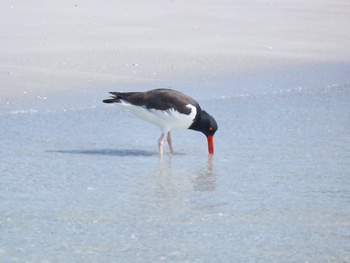Beach birds considered for threatened status

CINDY LANE | SUN
An American oystercatcher looks for dinner in Holmes Beach.
As bird nesting season arrives on Anna Maria Island, four imperiled species often seen on local beaches are among those being targeted by the Florida Fish and Wildlife Conservation Commission (FWC) for special protection.
The commission is recommending that the American oystercatcher and black skimmer, both state species of special concern (one step under threatened), join the snowy plover and least tern as state threatened species (one step under endangered).
The birds, which lay their eggs on Florida beaches, are declining in number due to habitat loss, according to the FWC, which is developing a draft plan that fosters voluntary, community-based efforts to conserve them.
Input from beach property owners and other interested members of the public is invited on the draft plan to protect the birds, and four other species – the alligator snapping turtle, Florida bonneted bat, white-crowned pigeon and Florida tree snail. The eight species are among 60 that the FWC is unveiling conservation plans for this year.
You can read the draft plan and comment on it through April 23 at http://share1.myfwc.com/ISMP/default.aspx.
Threats to the birds listed in the draft plan include feral cats, people feeding birds, unleashed dogs, fireworks, low flying aircraft, beach driving, beach raking, invasive plants and coastal armoring.
The plan suggests conservation measures that include developing a comprehensive shorebird/seabird program, annual identification of priority conservation sites, working with land managers and governments to implement seasonal restrictions on public recreation areas that overlap nesting habitat, implementing management plans for certain sites, creating artificial habitat, encouraging management of breeding sites, restoring and enhancing habitat, creating enforceable civil infractions for nesting sites, posting breeding sites and improving bird population monitoring and minimizing predation.
Among the plan’s suggestions for local governments:
• Capitalize on ecotourism, largely consisting of birdwatchers, by voluntary designating bird-friendly beaches.
• Offer incentives to beachfront property owners, such as increasing residential density or building heights, in exchange for conservation easements on nesting habitat.
• Develop incentives for property owners to remove tall, non-native trees such as Brazilian pepper, Australian pine and carrotwood, which serve as perches for avian predators of nesting birds.
• Incorporate bird nesting protection into permits for sports events, film productions, weddings, fireworks displays and other locally regulated special events.

